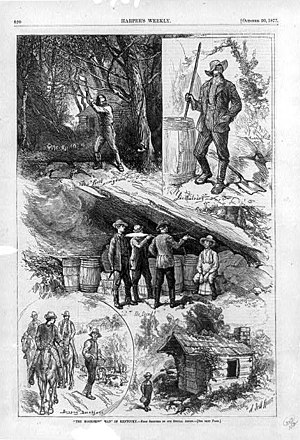Moonshine
From Wikipedia, the free encyclopedia
- Not to be confused with moonlight. For other uses, see Moonshine (disambiguation).

The Moonshine Man of Kentucky, illustration from Harper's Weekly, 1877, showing five scenes from the life of a Kentucky moonshiner
Safety
Poorly produced moonshine can be contaminated, mainly from materials used in construction of the still. Stills employing used automotive radiators as condensers are particularly dangerous; in some cases, glycol, products from antifreeze, can appear as well. Radiators used as condensers also may contain lead at the connections to the plumbing. Both glycol and lead are poisonous and potentially deadly.Although methanol is not produced in toxic amounts by fermentation of sugars from grain starches,[3] contamination is still possible by unscrupulous distillers using cheap methanol to increase the apparent strength of the product. Moonshine can be made both more palatable and less damaging by discarding the "foreshot"—the first few ounces of alcohol that drip from the condenser. The foreshot contains most of the methanol, if any, from the mash because methanol vaporizes at a lower temperature than ethanol. The foreshot also typically contains small amounts of other undesirable compounds such as acetone and various aldehydes.
Alcohol concentrations above about 50% alcohol by volume (100 proof) are flammable and therefore dangerous to handle. This is especially true during the distilling process when vaporized alcohol may accumulate in the air to dangerous concentrations if adequate ventilation has not been provided.

Former West Virginia moonshiner John Bowman explains the workings of a still. November 1996. American Folklife Center
Tests
A quick estimate of the alcoholic strength, or proof, of the distillate (the ratio of alcohol to water) is often achieved by shaking a clear container of the distillate. Large bubbles with a short duration indicate a higher alcohol content, while smaller bubbles that disappear more slowly indicate the increasing presence of water.A common folk test for the quality of moonshine was to pour a small quantity of it into a spoon and set it on fire. The theory was that a safe distillate burns with a blue flame, but a tainted distillate burns with a yellow flame. Practitioners of this simple test also held that if a radiator coil had been used as a condenser, then there would be lead in the distillate, which would give a reddish flame. This led to the mnemonic, "Lead burns red and makes you dead."[4] Although the flame test will show the presence of lead and fusel oils, it will not reveal the presence of methanol (also poisonous), which burns with an invisible flame.[5]
Prevalence
Main article: Moonshine by country
Varieties of moonshine are produced throughout the world.See also
References
Notes- Jump up ^ Ellison, Betty Boles (2003). Illegal Odyssey: 200 Years of Kentucky Moonshine. IN: Author House. p. 1. ISBN 978-1-4107-8407-0.
- Jump up ^ Kellner, Esther (1971). Moonshine: its history and folklore. IN: Bobbs-Merrill. p. 5.
- Jump up ^ "Distillation: Some Purity Considerations", A Step By Step Guide
- Jump up ^ "Moonshine". Skylark Medical Clinic. Retrieved 2008-07-23.
- Jump up ^ Methanol Institute[dead link]
- Davis, Elaine. Minnesota 13: "Wet" Wild Prohibition Days (2007) ISBN 9780979801709
- Peine, Emelie K., and Kai A. Schafft. “Moonshine, Mountaineers, and Modernity: Distilling Cultural History in the Southern Appalachian Mountains,” Journal of Appalachian Studies, 18 (Spring–Fall 2012), 93–112.
- Rowley, Matthew. Moonshine! History, songs, stories, and how-tos (2007) ISBN 9781579906481
- Watman, Max. Chasing the White Dog: An Amateur Outlaw's Adventures in Moonshine (2010) ISBN 9781439170243
No comments:
Post a Comment
Please leave a comment-- or suggestions, particularly of topics and places you'd like to see covered